Category Archives: Intern Update
Last workshop at USAC
The last couple of days I have been making my posters for the 10 Things Men and Women can do, respectively. Also, Simón and I saw an awesome dance performance of a group of Costa Rican dance students last night.

10 Things Women can do for Self Protection and/or Risk Reduction
Today was our last workshop at USAC and the students were assigned to create a group project to perform or present this week, so there were several skits, songs, presentations, and art work. The students were also asked to write letters to themselves making a promise to change something in their lives that would help prevent violence. This proved to be moving as several students read their letters out loud. One particularly touching letter was written by “student,” Zully Soberalis, survivor of intimate partner violence and the director of Escuela Oficial Rural Mixta Santa Barbara in Zone 18, the location of MIA’s pilot program.

Zully Soberalis and I outside of the classroom A group presentation

A skit about male misbehavior; pictured here are “mother” and “son”

A group presentation

One of the students demonstrating types of violence

A close up of one of the group’s visual aid

This group made a collage of how the media influences societal values

This very musical group sang a song they wrote

A “husband” and “wife” square off over equal domestic labor
After the students read their letters and did their group presentations, they had to get into pairs and light each other’s candles while sharing personal goals for self-improvement. This was fun for me because I got to participate with a male student and he was really interested in my goal of teaching my newborn nephew as he grows up about gender equality and alternative models of masculinity. His goal had to do with not looking down on people. We then got to know each other a little and he was blown away at my life experience, specifically that I didn’t live with my family and had worked since I was 16.
I explained a lot of misconceptions about the U.S. such as the ideas he had about justice by relaying stories of my experiences as a rape crisis counselor. We also discussed racism and the differences between racism in the U.S. and racism in Guatemala and how immigration ties in.

Candle lighting ceremony and my ceremony partner
Then, sadly, it was time to end our last session of workshops at USAC and we all said out goodbyes. I felt really sad that I wouldn’t see this group again as I had grown fond of all of them.
Tomorrow I am going to make the detailed schedule for Epsum/Volusac so Simón and I can begin with our next group.
Out and about in Guatemala City
Thinking back on my visit to my friend’s house last Saturday, I can’t help but feel like being here as a gringa woman is so incredibly different then if I lived here like she does. My friend is a year younger than me and still has to ask permission to go anywhere, invite her friends to her house before going to theirs, and sleeping over anywhere is unheard of. The lack of freedom is unreal, and though she doesn’t share much about how her family treats her, I have heard enough to know that she lives a hard life.
We watched the movie and went to the market for some chicken and then she made an early dinner for us. The kitchen lights didn’t work and she had to cook on a portable burner because the stove was broke. After dinner she took the first two busses with me so I wouldn’t get lost and then Simón met us and took the last two with me. Getting around here is really complicated. My friend and I had a good time, but at the end of the day I was glad to be back to the house I am staying in.

My friend a few weeks earlier at Pollo Campero
Today was the inauguration of the new IUMUSAC headquarters. Simón and I arrived bright and early to attend the brief series of ceremonies in their new office and next door at IDHUSAC, the Human Rights Institute of USAC. The ceremony was also to recognize the president of USAC, Lic. Estuardo Galvez, and the Secretary General, Dr. Carlos Alvarado Cerezo, for their contribution and support of Guatemalan women university students.

The plaque of recognition
After the ceremony we were drinking coffee and Pili, one of the students from the USAC workshops approached Simón and I about doing workshops with VOLUSAC, a USAC volunteer group she has been working with. We agreed to meet with her tomorrow and exchanged contact information.
Next, we went to the Palacio Nacional so Simon could pick up a paycheck from one of his cuaderno workshops and I decided to visit my friend Jenny in the office of the Palacio’s art gallery. Jenny and I made a lunch date for the next day at 1pm, after my meeting with IUMUSAC and before the meeting with VOLUSAC and I was excited to be planning for my first real outing where I would need to walk alone.

The Palacio Nacional
Change and Action
Today I met with Pati and Carlos at IUMUSAC to discuss last week’s workshop and plan for next week’s. Since next week is the last session and we will be speaking about change and action, I suggested that we use Jackson Katz’s “10 Things Men Can Do to Prevent Gender Violence.” Pati loved the idea, but to my dismay asked me to write it all out on a poster board and to create one for women. Since Jackson’s list is already translated and already created that wasn’t too much to ask, but to actually create one for women and then translate it into Spanish, and then make it into a poster wouldn’t be easy. But I agreed and said I would bring them next week. Now to brainstorm about how to speak about women’s role in prevention since only the perpetrator can prevent his actions. Pati and Carlos also spoke about the closing ceremony for next week which they decided would consist of each student stating one thing they will do to change their behavior to prevent violence in their lives. Carlos said he would get white ribbons to give out again and Pati would bring candles for the students to light when describing their commitment.
 After the meeting, I went to the Palacio Nacional and met with my friend Jenny and her friend Ana for lunch. I invited them to join Simón and me later that night to see a Foto 30 exhibit at the Edificio de Correos and she said she would come. After lunch (Pollo Campero) we walked next door to Correos so I could meet with Simón before our meeting with Volusac and so Jenny and Ana could see Simón’s office. We said bye to the girls and then Simón and I were off to the meeting. Though the meeting took place at the Volusac office, the workshops they were inviting us to give were going to be in collaboration with groups in Zone 6 called Programa Adulto Mayor and Epsum. They initially invited us to do one workshop but we explained that we normally do 10 workshops, so they said that if we can fit into the schedule they already have of eleven three-hour workshops then we can do more. Amalia and Alex, two social work students at USAC will be facilitating the sessions that we don’t or splitting the sessions half and half if we decide not to do the full 3 hours.
After the meeting, I went to the Palacio Nacional and met with my friend Jenny and her friend Ana for lunch. I invited them to join Simón and me later that night to see a Foto 30 exhibit at the Edificio de Correos and she said she would come. After lunch (Pollo Campero) we walked next door to Correos so I could meet with Simón before our meeting with Volusac and so Jenny and Ana could see Simón’s office. We said bye to the girls and then Simón and I were off to the meeting. Though the meeting took place at the Volusac office, the workshops they were inviting us to give were going to be in collaboration with groups in Zone 6 called Programa Adulto Mayor and Epsum. They initially invited us to do one workshop but we explained that we normally do 10 workshops, so they said that if we can fit into the schedule they already have of eleven three-hour workshops then we can do more. Amalia and Alex, two social work students at USAC will be facilitating the sessions that we don’t or splitting the sessions half and half if we decide not to do the full 3 hours.

- Alex, Amalia, a woman from Volusac, me and Simón
The schedule is:
9/16 1. Que es genero
9/23 2. Que es violencia intrafamiliar
9/30 3. Tipos de Violencia: Fisica, Psiquica, Sexual, Patrimonial, Domestica, y Cotidiana
10/7 4. Violencia Intrafamiliar contra la ninez
10/14 5. Indicadores de sospecha de los agresores
10/21 6. Fundacion sobrevivientes
10/28 7. Frases de apoyo y defender nuestros derechos
11/4 8. Fundamento legal
11/11 9. Derechos Humanos
11/18 10. Sugerencias a padres de la familia
11/25 11. Evaluacion y clausura
Since I will be leaving back to the US on Oct 29, I really could only choose from the first five since the 6th is with another group, Sobrevivientes. I decided that we could fit into 4 of the sessions, 1-3 and session 5 for an hour and a half each. They said that was fine and to send an outline of what we are going to do so we make sure we aren’t being repetitive and that we fit within their subject for each session. I said I would send the outlines as soon as possible and exchanged contact information with Amalia.
After the meeting, Simón and I met up with Jenny and Ana at the Foto 30 exhibit. It was a nice ending to a long day and I was able to take my mind off all my new homework for a little while.

- Jenny, Ana and I
USAC Workshop, testing my Spanish
Today was my big premiere of my Spanish in front of the USAC students. I am comfortable with the material and can explain things like the power and control wheel off the top of my head, but in Spanish, everything changes and I suddenly become nervous. To combat the fear of suddenly forgetting a word or idea while in front of the class I wrote myself a script.
Today’s workshop began with Carlos speaking about gender and sexual fluidity. The next portion was about figuring out where everyone’s personal limits are for negative behavior in a relationship. Everyone in the class had to get into groups and individually cut out about 10 different situations taken from worksheets and paste them onto a line in order between the two extremes of “permitted” and “not permitted.”

Carlos explaining the exercise

One of the groups making their chart
Everyone had different limits of what they would tolerate in a relationship, and the exercise seemed to help each person realize their limits and realize that everyone’s limits will be different.
Next was my part about power and control. I think I got through everything ok, and the class was incredibly respectful and listened intently to my speech. As I looked around at everyone I almost became emotional because I felt so welcome and could see them trying to make me feel comfortable.

My home-made power and control wheel

Class discussion
Afterward, there was class discussion followed by their assignment for next week: in groups, make a creative presentation based on the ideas presented in the workshops. Also, individually they are to write a letter to themselves about how they can change to prevent violence in their lives. I was so relieved that my speech was over and went well that right after class I had my first meal for the day, a pupusa with salsa made by a woman on the USAC campus. Yum! And later that night I was finally able to have my bread-feast! And it was SO delicious! Afterward I went down to the 6ta calle and bought a pirated copy of In the Time of Butterflies to watch with my friend mañana.

Me and Carlos enjoying pupusas

My bread and brie feast
Tomorrow I am going to my friend’s house for the first time and am a little nervous to take the long trek all the way to Colonia Lobos II, a pueblito that consists of taking at the very least 4 buses. I will be taking a taxi in lieu of the first bus to USAC to meet her and then we will make the 3 bus-trek together because I am positive I will get lost if I do any bussing alone.
Inmigration Issues
Today is the last day of the huelga de hambre or in my case huelga de pan. This morning Simon and I attended a conference on immigration at the Radisson Hotel in Zone 10 (the rich zone) to support Carlos since he would be speaking. I also wanted to go because I was curious about how people here in Guatemala regard immigration/migration.
In my community in the U.S., there are bastantes migrantes and therefore many immigration and immigrants-rights related events. I am from Ontario, California, and right now many of us from my area are actively fighting against the various forms of anti-immigrant sentiment and racism, whether overt or covert. This sentiment manifests in many forms, ICE raids, Nazi, Minute Men and KKK protests of day labor sites, “sobriety” checkpoints, and Border Patrol raids including those on Greyhound buses. The immigrant community and its allies have successfully mobilized and have several formal and informal networks of communication to organize counter-protests, vigils, celebrations, warnings, and support.

- Pitzer Professor Martha Bárcenas-Mooradian warns drivers of upcoming checkpoint in Pomona, CA to prevent the seizures of the vehicles of immigrants
The most detrimental of the various anti-immigrant manifestations are the ICE raids, as the workers are generally imprisoned before being deported such as in Postville, Iowa raid which imprisoned and then deported almost 400 Guatemalan workers.
Video about the Postville raid
The day labor site closest to my house is in Rancho Cucamonga, CA on the corner of Grove and Arrow, though it is now a site of remembrance as well for fallen day labor leader Fernando Pedraza who was fatally wounded by a vehicle crash in May 2007. Many have stated that the crash would not have happened if the anti-immigrant group the Minuteman Project was not protesting the day laborers and therefore distracting drivers and preventing the workers from being hired. Another factor was the recent closing of the day labor center, forcing the laborers to stand on the sidewalk while they awaited work.

A photo of Jose Fernando Pedraza from the commemoration of the 1st anniversary of his death
In any case, I was curious about how Guatemala treats their undocumented. However, once at the event I picked up a schedule and the booklet from the sponsoring organization MENAMIG, the National Bureau for Migration in Guatemala, and realized that the event would solely be dealing with Guatemalans who go north and not at all with immigrants who come to Guatemala. Carlos began by speaking about the statistics and numbers of Guatemalan migrants who leave to the U.S. as well as those that are deported, and next a speaker from MENAMIG spoke about the treatment of Guatemalan immigrants in the U.S., laws pertaining to immigrants, and how the news media portrays immigrants. Generally, it was bad news: the US exploits its immigrant workforce, deports undocumented peoples at alarming rates, and views immigration negatively. However, while speaking about Guatemalans working in the US he showed a photograph of Norma Torres and Barack Obama with the caption “Lideresas políticas: Norma Torres, ‘La chapina, Orgullo de Guatemala.’”

Political women leaders: Norma Torres, “The Chapina, Pride of Guatemala”
Norma Torres is the former mayor of Pomona and now an assembly member in the 61st district. She is the highest ranking official in the US from Guatemala and a great source of pride for many Guatemalans (many of which call themselves “Chapines/as”), as well as an example of the American Dream many have. I thought about how Pomona, a city with an incredibly high population of immigrants, has checkpoints every two weeks. This is a rate higher than any city I have heard of, and while Norma was mayor she maintained a pro-checkpoint stance, much to the anger of the immigrants’ rights activists in Pomona. However, I have hope that now that she is an assembly member she will step up her long time stance as an advocate for giving drivers licenses to undocumented people, and make Guatemalans in both countries proud.

Carlos Ibáñez and Álvaro Caballeros of MENAMIG
After all the speakers finished discussing US treatment of Guatemalan immigrants there was a question and answer period. I hadn’t had adequate time to reflect on all that I had heard yet, plus it was still early for me, but when I think back on what I would have asked I think I know what I would say. You see, many people here in Guatemala don’t know that the US isn’t welcoming nor that the American Dream is a huge lie, but since I am norteamericana I already know that and was hoping to learn something specific to Guatemala. So my questions would be: “What is Guatemala doing for immigrants in Guatemala? How is Guatemala preventing migration? And how is Guatemala supporting the deported?”
After the conference Simón showed me some amazing murals and buildings that were nearby the Radisson, and finally saw my first queer/gay public service billboard. It was incredibly exciting! Another exciting thing: tomorrow I can eat bread!

One of my favorite murals

The billboard, paid for by CCE/G
Stolen babies
Yesterday and today were long without bread! Every meal here is served/prepared with bread on the side and it looks SO good. Also, in the mornings, the streets are filled with the scent of fresh baked bread from the panaderias. But when I look at these three photographs of Angeli Lisseth Hernandez Rodriguez, Heidy Sarai Batz Par, and Arlene Escarleth Lopez, I know that whether or not my small gesture of solidarity changes anything, that the three mothers fighting for family reunification deserve support, regardless of the form. It is important to mention that here in Guatemala when people question or challenge the justice system is when they are most likely to end up disappeared or having to flee the country due to threats, so the three women, along with Sobrevivientes and other supporters of this campaign are risking personal harm in the name of justice.

Angeli Lisseth Hernandez Rodriguez, Heidy Sarai Batz Par, and Arlene Escarleth Lopez.
A little bit about the daughters:
According to the 3 days for 3 daughters website, Angeli Lisseth Hernandez Rodriguez, daughter of Loyda Rodriguez, was kidnapped November 3, 2006 from her front yard in Villa Hermosa, San Miguel Petapa, Guatemala City. She is now believed to now be in Missouri. Heidy Sarai Batz Par, daughter of Raquel Par, was kidnapped April 4, 2006 on a bus in Guatemala City. She is believed to be living in Iowa and is now 4 years old. Arlene Escarleth Lopez, daughter of Olga Lopez, was kidnapped from Olga’s mother in Guatemala City September 27, 2006. She is now believed to be living in Illinois.
I recently read an article on CNN.com about how the Guatemalan army stole children (at least 333) to sell into adoption during the 36 year civil war. The article quoted Marco Tulio Alvarez, the director of the Guatemalan Peace Archive (the commission that began investigating these cases beginning in May 2008) as saying “Guatemalan society must know what happened and must never allow it to happen again.” This statement sounds hopeful and strong, but what the article and the commission is clearly lacking is the knowledge that kidnapping children to sell for adoption is not something of the past-it is still going on.

Lucia and the director of the night school planning our calendar last week
Last night was supposed to be me and Simón’s second workshop at the night school without Lucia, but when we got there we were told that the school is in the middle of a strict study schedule for their national testing and could not spare time for the workshop. We searched for Daniel Silvestre, the director of the school, and requested to meet in order to make sure that he knew that just because Lucia went back to California doesn’t mean the campaign is over. We sat down in his office and pitched the campaign (Hombres Contra Feminicidio) all over again since our first pitch was to the assistant director, Mirna Sanchez. He seemed interested and was open to the idea of us returning at the beginning of the next school year, but told us that because school is ending soon there just wasn’t time for us this year. (Schools here in Guatemala start in January and end in October) We had to push so we could at the very least have a closing session with the classes and finally we were able to schedule two closing sessions after the testing, the holiday (September 15 is Independence Day) and before finals. Our last days will be September 17 and 22. We left happy that we got something, but were disappointed that we couldn’t work last night.

Simón with the batik journals he makes from scratch in the Gran Hotel, a local café/bar/venue which also helps local artists sell their handicrafts
Today I visited Simón at his office in Edificio de Correos (the mail building). He uses the office space for two purposes, to create his productos artesanales (handicrafts) from which he earns his income and as a headquarters for his poetry and art collective, S.o.P.a., Sociedad Optativa de Poetas Anónimos (the optional anonymous poets society). S.o.P.a. is a literary group of mostly young people which is dedicated to promoting the art of writing through different means of artistic expression such as poetry, painting, photography, film, music, multimedia presentations, workshops and exhibitions. A recent article about can be found HERE.
A video of Simon reading his poetry in the street after a festival in Dec 08 in front of an installation created by artist Maya Lemus
After visiting S.o.P.a., we went to eat lentil soup with some friends at a place called Bar Europa and the bread sat in the middle of the table taunting me, wanting me to dip it in the soup! But I remained strong. Tomorrow is the last day of the huelga, and since Carlos is picking us up at 6:30am tomorrow for an immigration conference, it will be a very long day without bread!

The door at bar Europa.
CONIC and some more…
Monday Carlos and I went to IUMUSAC and met with Pati. We looked over the student reviews of the previous week, discussed the schedule for next week, and while we were talking I suggested we use the Power and Control wheel. They liked my idea but I then had the assignment of drawing it on a poster board and explaining the wheel next week in front of everyone! Since it is pretty complex and there is a lot to say, I had the fun task of writing myself a script in English, translating it into Spanish, and drawing the huge thing, all of which I did on my weekend “off.” But back to Monday: after the meeting, Carlos and I had our own mini-meeting in a nearby café and discussed masculinity, men’s role in women’s groups, men’s emotional health, and possible future plans for Hombres Contra Feminicidio. We also discussed how queerness and gender binaries are inseparable issues and it was a refreshing change to talk to a like minded feminist about breaking the “boxes” and binaries of gender and sexual orientation.
As we walked to go our separate ways: me to meet Simón at the Edificio de Correos (the mail building where his office is located) and Carlos to go to another meeting, we happened upon an Indigenous Rights protest so we walked over to check it out.
It appeared to be organized by CONIC, Guatemala’s National Coordination of Indigenous Peoples and Campesinos, an organization which was established to promote sustainable livelihoods and community-led development for indigenous peoples across Guatemala.

“Women who fight, win”

Aug 31, 2004 — Massacred: Peasant minors were tortured and died at the location due to the seriousness of the wounds, strikes, and burns.

Showing the police the gruesome pictures of massacred and assaulted indigenous people
Unfortunately, it is impossible to fight for Indigenous rights such as language inclusion (since there are about 24 Mayan languages in Guatemala) and access to resources such as water and education without also demanding justice for the Mayan genocide that took place during the civil war and the continued massacres, beatings, and terrorism of Indigenous communities. Being here in Guatemala is inspiring because there are so many fearless people who fight for rights they know they deserve, even though activism here is often rewarded with death threats, drive by’s, robberies, kidnappings, and murder. There is no way to look at just women’s rights, indigenous rights, the rights of the poor, etc. without seeing that all oppressions are intrinsically connected and all struggles are really one struggle. Here in Guatemala the oppression of Indigenous peoples is very obvious since the government, the media, and the middle and upper class people are made up of Ladinos, the generally lighter-skinned mixed race Mestizos, and in reality the population of Guatemala is about half Indigenous and half Ladino, even with the 200,000 Mayans who were massacred during the war.
Tomorrow begins my “huelga” in solidarity with the women whose babies were stolen, specifically three daughters of Guatemalan mothers who now live in the U.S. with adoptive parents. For more information on the issue of stolen babies please see this video. I am going to be giving up bread, one of my favorite things to eat, especially here where a lot of my favorite foods don’t exist, and Simon will be giving up his big food-vice: chocolate. Wish me luck!
…
Triciclo
Today Lucia and I went to meet with Shenny, the teacher from the night school, because she has a women’s group that meets weekly. We informed the women about MIA and Hombres Contra Feminicidio and showed our short DVD’s: one about the campaign in the Santa Barbara school and the other the short film The Impossible Dream (VIDEO LINK HERE), a cartoon about the gendered division of labor. Afterward we facilitated discussion on gender and violence and the women shared personal experiences.
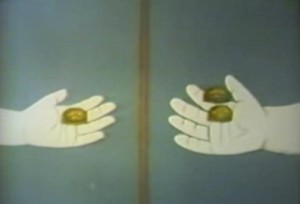
A screen shot from the short film “The Impossible Dream”
After the group, we had to say our goodbye’s since Lucia was going to spend her last weekend with her family. She wished me luck and then I was on my own.
That night was a big night for Simón because a book he edited and physically assembled was being released and he had been running around all week making sure everything was ready for the release party on top of work with MIA. The party was held at Libre Café, a cool red building in Zone 1. The book, Triciclo, is a collection of short stories by an author named Juan Calles.
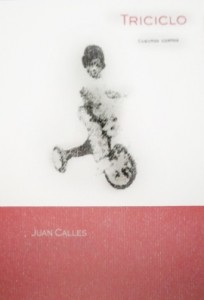
The book
The event was a huge success, there was a large audience, many books were sold, and my friend Jenny came and we were able to relax and talk about things other than work. This is the beginning of my first weekend off since I’ve been here, then I start work first thing again Monday morning with the next meeting with IUMUSAC.
Juan Calles reading one of his stories: Watch video below
Second workshop at USAC
Today was our second workshop at USAC and there were just as many people here today as there were last week, something that surprised me. Since the certificate program does not provide school credits, I thought people might check out what we were doing and then not come back. Anyway, today was fun because it started with an exercise on sexism in the media and most of the class (including Carlos, Simon and I) got up to dance to the two songs Carlos put on.
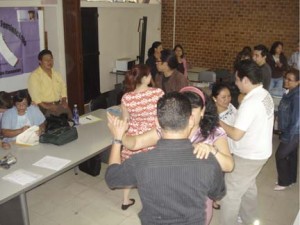
Us dancing
One was faster, and one sounded more slow and romantic. After dancing the students discussed the lyrics of the songs and analyzed their content, since both songs were incredibly sexist.
Next, the students broke up into small groups and read a recent article from El Diario La Hora, and had to make conclusions based on the article and present them in front of the class.
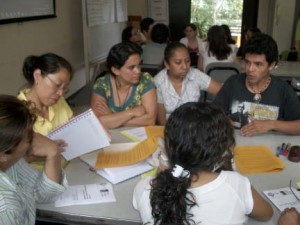
One group discussing the article
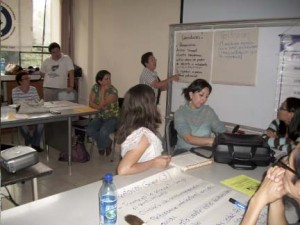
Presenting conclusions
The woman talking is from Caja Lúdica! Good thing she came, she was brilliant.
Lucia said her goodbye’s to the class since she is today to symbolize that I am continuing the campaign leaving this weekend and won’t be here for the last two classes.

This is the baton/paintbrush Lucia gave me at the USAC
After the presentations there was lively discussion about feminism and gendered violence, and Lucia and Carlos passed out the white ribbons which symbolized taking a pledge to join the fight against gender violence.
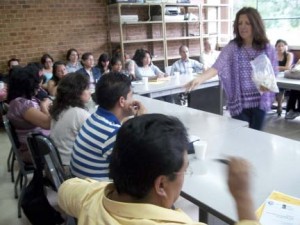
- Handing out the ribbons
After class today, everyone swarmed
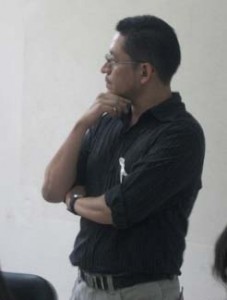
- Carlos wearing his
Lucia and me to make sure they had our correct contact information and to turn in anything they hadn’t turned in, and we reassured them that though Lucia was leaving, MIA was staying here. The baton is now mine; I hope I can do MIA justice!
Lucia and the women from IUMUSAC
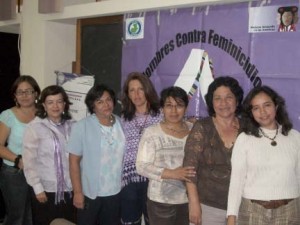
IUMUSAC and MIA








 Proud Founder Member of the Guatemala Peace and Development Network
Proud Founder Member of the Guatemala Peace and Development Network